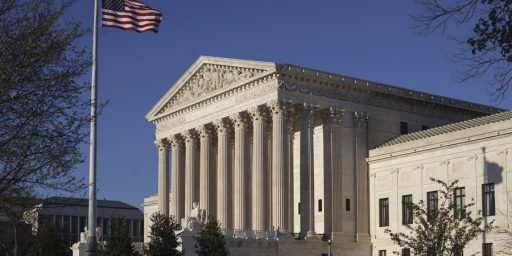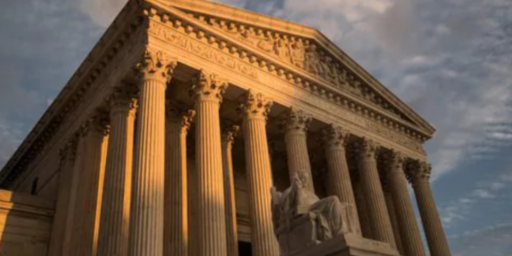REACTION ROUNDUP
As one might expect, there are numerous editorials today on yesterday’s affirmative action decisions. Here’s a sampling gleaned from RealClear Politics and other sources:
- Terry Eastland notes the irony that the diversity rationale is the worst form of tokenism, writing that O’Connor fails to
examine why, as one black Michigan student told The Journal, diversity has become “offensive to students of color. [It is] as if we’re just in college to enrich the education of white students.”
- Jonathan Turley calls it a “decision only Goldilocks could love” and thinks, unlike me and most of the other analysts I’ve read or heard, that this decision may soon be overturned:
All of these points are contested by the four dissenting justices. Thus, much of this decision could evaporate with a seemingly innocuous tweaking of one of these elements by a new court majority, should one of the justices retire.
The dissenting justices may have sown the seeds for precisely such a later rematch. In the undergraduate case, these justices left open the question of the precise weight that can be given to race, while ruling that Michigan was clearly excessive in its program. This will trigger countless challenges using the rejected Michigan program as a benchmark.
- Clint Bolick thinks the decision a step backward and notes the bitter irony that continuing racial preferences ignores the gap that makes them “necessary” to begin with:
Equally tragic, the decision leaves unsolved a racial gap in academic performance that leads to huge disparities in postsecondary education. By creating the cosmetic illusion of academic progress, racial preferences make us think we are reducing the academic gap when in fact it is growing.
The average black high school senior achieves at a level roughly four academic years behind the average white senior. Massive preferences like the University of Michigan’s merely leapfrog the best-qualified minority students while doing nothing to close the academic gap and help those left behind. Indeed, they harm efforts toward racial equality by making people think the gap is closing, when in fact it is widening.
- Slate features a discussion between Walter Dellinger and Dahlia Lithwick, written before the opinion was announced. Dellinger makes an argument, harkening back to the 1950s civil rights cases, that the Court should try to achieve a consensus position rather than voting according to the individual preferences of the justices:
Is it not possible (and perhaps desirable) that, say, six justices could come together on a single opinion resolving the two cases that reflects a consensus of that group as a whole, while not necessarily reflecting the individual views of each of those who join? For reasons I may have a chance to elaborate later this week, the fine line at the center of the court may fall between the undergraduate and law school programs. It is possible that the undergraduate program is more vulnerable on the narrow grounds that race is a factor worth 20 additional points in the admissions process. If a person of complex racial grandparentage applies to the college, someone (usually the applicant) has to decide whether that person is in fact “in” or “out” of one of the designated racial groups. There is no way to give eight or 13 points for race. No such determination need be made under the law school’s system. Each file is read as a whole and each member of the admission’s committee asks what this person’s experience, including racial experience, adds to the mix of our class.
Lithwick is intrigued by this idea, but skeptical:
But I can’t help but wonder if forcing “group” decisions wouldn’t lead to even more tactical and strategic behavior on the part of the justices. Wouldn’t we prefer that each justice ultimately vote his or her conscience, rather than having them lobby one another, collude, and swap votes? (I know, I know, they do that already, but let me have my illusions.) In any event, this issue dovetails nicely with the problem at the heart of the affirmative action cases: whether groups or individuals are guaranteed rights in this country. How ironic that the high court will decide, as a fractured group of individuals, the future of group rights.
No joke.
Update (1031): Dean Esmay concludes his reaction to a WSJ editorial on the case this way:
Before I say more that just gets me in trouble, I’ll repeat something that Justene Adamec said to me yesterday: 25 years ago, they called me a hard-core liberal because I vigorously opposed discrimination based on race. Now they call me a right-wing extremist because I vigorously oppose discrimination based on race. Go figure.
Indeed.





